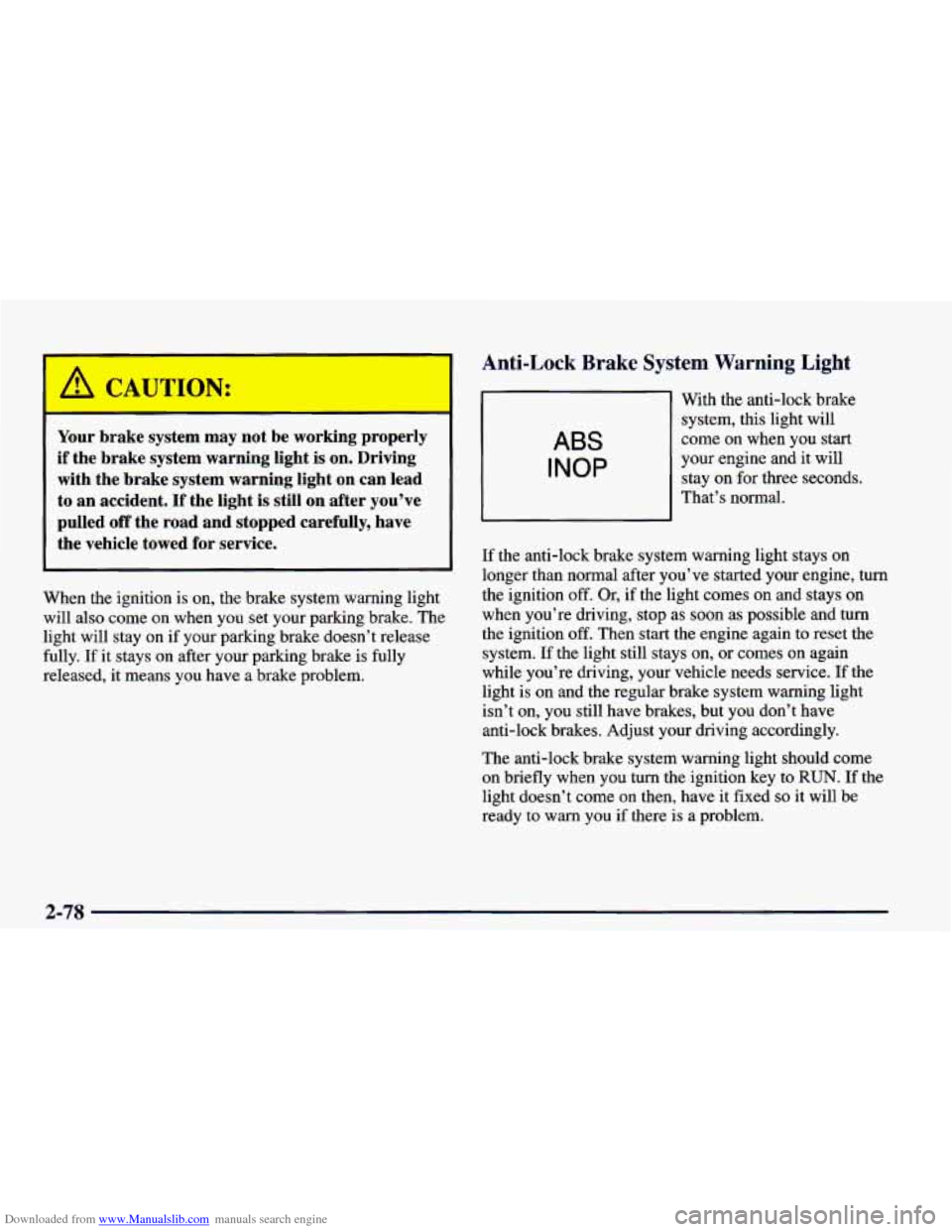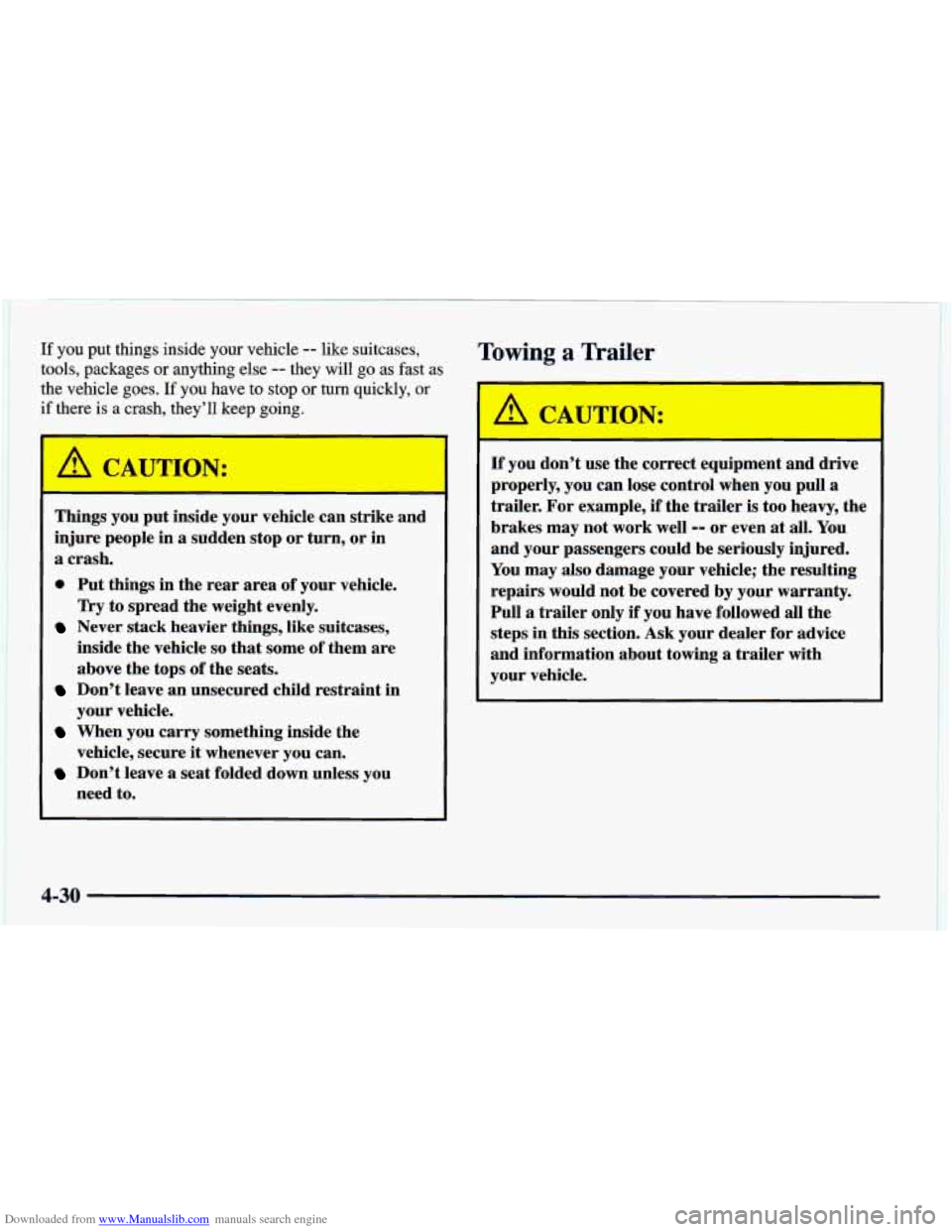1998 CHEVROLET CAMARO tow
[x] Cancel search: towPage 131 of 402

Downloaded from www.Manualslib.com manuals search engine NOTICE:
Do not attempt to install the panels by sliding
them horizontally toward the center roof rail.
Doing
so may cause the weatherstrips to be
aligned improperly, which may result
in leaks
and possible damage
to the weatherstrips.
I NOTICE:
High pressure car washes may cause water to
enter your vehicle. Never spray water directly at
the roof panel joints. This will cause leaks.
T-Top Sunshades
1. Start with the panel marked DRIVER FRONT.
Unlatch the driver’s side T-top, raise it halfway
and close the latch handle.
2. With the top raised and resting on the center roof
rail, slide the flat edge of the sunshade panel (with
the vinyl side to the glass) between the glass and
plastic trim, making sure the edge marked DRIVER
FRONT
is pointing to the front of the vehicle.
2-63
Page 145 of 402

Downloaded from www.Manualslib.com manuals search engine Voltmeter
You can read battery
voltage
on your voltmeter.
If it reads less than 11 volts
or more than
16 volts while
your engine is running,
8 and it stays there, you may
have a problem with the
electrical charging system.
If you must drive a short distance with the voltmeter
reading in a warning zone, turn
off all your accessories,
including your air conditioning system and audio system.
Brake System Warning Light
Your vehicle’s hydraulic brake system is divided into
two parts.
If one part isn’t working, the other part can
still work and stop you. For good braking, though, you
need both parts working well.
If the warning light comes on, there could be a brake
problem. Have your brake system inspected right away.
Have it checked right away. Driving with the voltmeter
reading in a warning zone could drain your battery.
If you idle your engine for a while, the voltmeter
reading might move into the low voltage zone (indicated
by red dots). If the reading stays in
the low voltage zone
while you are driving, you may have a problem with the
electrical charging system. Have it checked. While the
voltmeter reads in the low voltage zone, your battery
may not be able to power certain electrical accessories,
like ABS.
(If this happens, your ABS INOP light will
come
on. See “Anti-Lock Brake System Warning Light”
in this section.)
BRAKE
This light should come
on briefly when you turn
the ignition key
to RUN.
If it doesn’t come on then,
have it fixed
so it will be
ready to warn you if there’s
a problem.
If the light comes on while you are driving, pull off the
road and stop carefully. You may notice that the pedal is
harder to push. Or, the pedal may go closer to the floor.
It may take longer to stop.
If the light is still on, have the
vehicle towed
for service. (See “Towing Your Vehicle’’
in the Index.)
2-77
Page 146 of 402

Downloaded from www.Manualslib.com manuals search engine Your brake system may not be working properly if the brake system warning light is on. Driving
with the brake system warning light on can lead
to an accident. If the light
is still on after you’ve
pulled
off the road and stopped carefully, have
the vehicle towed for service.
When the ignition is on, the brake system warning light
will also come on when you set your parking brake. The
light will stay on if your parking brake doesn’t release
fully. If it stays on after your parking brake is fully
released, it means you have a brake problem.
ABS
INOP
Anti-Lock Brake System Warning Light
With the anti-lock brake system, this light will
come on when you start
your engine and it will
stay on for three seconds.
That’s normal.
If the anti-lock brake system warning light stays on
longer than normal after you’ve started your engine, turn
the ignition
off. Or, if the light comes on and stays on
when you’re driving, stop as soon as possible and turn
the ignition off. Then start
the engine again to reset the
system. If the light still stays on,
or comes on again
while you’re driving, your vehicle needs service.
If the
light is
on and the regular brake system warning light
isn’t on, you still have brakes, but you don’t have
anti-lock brakes. Adjust your driving accordingly.
The anti-lock brake system warning light should come
on briefly when you turn the ignition
key to RUN. If the
light doesn’t come on then, have it fixed so it will be
ready to warn you
if there is a problem.
2-78
Page 150 of 402

Downloaded from www.Manualslib.com manuals search engine If the Light Is Flashing
The following may prevent more serious damage to
your vehicle:
0 Reducing vehicle speed.
0 Avoiding hard accelerations.
0 Avoiding steep uphill grades.
0 If you are towing a trailer, reduce the amount of-
cargo being hauled as soon as it is possible.
If the light stops flashing and remains
on steady, see “If
the Light Is
On Steady” following.
If the light continues to flash, when it is safe to do
so,
stop the vehicle. Find a safe place to park your vehicle.
Turn the key
off, wait at least 10 seconds and restart the
engine.
If the light remains on steady, see “If the Light
Is On Steady” following. If the light is still flashing,
follow the previous steps, and drive the vehicle to your
dealer or qualified service center for service.
If the Light Is On Steady
You may be able to correct the emission system
malfunction by considering the following:
Did you recently put fuel into your vehicle?
If
so, reinstall the fuel cap, making sure to fully install
the cap. The diagnostic system can determine if the fuel
cap has been left off or improperly installed.
A loose or
missing fuel cap will allow fuel to evaporate into the
atmosphere.
A few driving trips with the cap properly
installed should turn the light off.
Did you just drive through a deep puddle of water?
If
so, your electrical system may be wet. The condition
will usually be corrected when the electrical system
dries out.
A few driving trips should turn the light off.
Are you low on fuel?
As your engine starts to run out of fuel, your engine may
not run as efficiently as designed since small amounts of
air are sucked into the fuel line causing a misfire. The
system can detect this. Adding fuel should correct this
condition. Make sure to install the fuel cap properly.
It
will take a few driving trips to turn the light off.
2-82
Page 156 of 402

Downloaded from www.Manualslib.com manuals search engine Comfort Controls
lhl
With this system, you can control the heating and
ventilation in your vehicle. If you have the air
conditioning option, you can also control cooling.
Your vehicle also has the flow-through ventilation
system described later in this section.
Fan Control Knob
# FAN: Turn this knob to select the force of air
you want.
Temperature Control Knob
Turn the knob to change the temperature of the air
flowing from the heating system. Turn it toward the red
or
to the right (clockwise) for warmer air and toward the
blue or to the left (counterclockwise) for cooler air. The
temperature of the air cannot be less than the
temperature of the outside air.
Air Control Knob
OFF: The system is off.
2 VENT Air flows through the upper air vents.
i
’!! BI-LEVEL: Air is directed through the upper air
vents and the heater ducts.
‘!A HEATER: This setting directs most of the air
through the heater ducts and some
of the air through the
windshield defroster vents.
9 BLEND: Air is directed through the windshield
defroster vents and the heater ducts.
9 DEFROST This setting directs most of the air
through the windshield defroster vents and some
of the
air through the heater ducts.
3-2
Page 158 of 402

Downloaded from www.Manualslib.com manuals search engine Heating Ventilation System
The heater works best if you keep your windows closed
while using it.
1. Turn the air control knob to HEATER.
2. Turn the fan control knob to the desired speed.
3. Turn the temperature control knob to a
If your vehicle is equipped with an optional engine coolant
heater, you can use it in cold weather (around
20°F/-8 “C
or lower) to improve heater performance on initial start up.
Because
an engine coolant heater warms the engine
coolant, your vehicles heating system can more quickly
and efficiently provide heat for your vehicle’s passenger
area. See “Engine Coolant Heater” in the Index. comfortable
setting.
Bi-Level Heating
You may want to use bi-level heating on cool, but sunny
days. This setting directs cool air toward your body and
warmer air toward your feet.
1. Turn the air control knob to BI-LEVEL.
2. Turn the temperature control knob to a
comfortable setting.
3. Turn the fan control knob to the desired speed. Adjust the direction of airflow by moving the louvered vents.
Your vehicle’s flow-through ventilation system supplies outside
air into the vehicle when it is moving. Outside air
will also enter the vehicle when the blower fan is running.
For mild outside temperatures when little heating or
cooling
is needed, you can still direct outside air through
your vehicle.
1. Turn the air control knob to VENT.
2. Turn the temperature control knob to a
comfortable setting.
3. Turn the fan control knob to the desired speed.
Page 181 of 402

Downloaded from www.Manualslib.com manuals search engine 0 Section 4 Your Driving and the Road
Here you’ll find information about driving on different kinds of roads and in varying weather conditions. We’ve also
included many other useful tips on driving.
4-2
4-2
4- 5
4- 6
4- 10
4- 12
4-13
4- 14
4-15 Defensive Driving
Drunken
Driving
Control of a Vehicle
Braking
Steering Off-Road Recovery
Passing
Loss of Control
Driving at Night 4-
17
4- 19
4-20
4-2 1
4-22 4-23
4-24
4-28
4-30 Driving
in Rain and on Wet Roads
City Driving
Freeway Driving
Before Leaving on a Long Trip
Highway Hypnosis Hill and Mountain Roads
Winter Driving
Loading
Your Vehicle
Towing
a Trailer
4-1
Page 210 of 402

Downloaded from www.Manualslib.com manuals search engine If you put things inside your vehicle -- like suitcases,
tools, packages or anything else
-- they will go as fast as
the vehicle goes. If you have to stop or turn quickly, or
if there is a crash, they’ll keep going.
-
CAUTION:
Things you put inside your vehicle can strike and
injure people in a sudden stop or turn, or in
a crash.
0 Put things in the rear area of your vehicle.
Never stack heavier things, like suitcases,
Try
to spread the weight evenly.
inside the vehicle
so that some of them are
above the tops of the seats.
Don’t leave an unsecured child restraint in
your vehicle.
When you carry something inside the
vehicle, secure
it whenever you can.
Don’t leave a seat folded down unless you
need to.
Towinp a Trailer
If you don’t use the correct equipment and drive
properly, you can lose control when you pull
a
trailer. For example, if the trailer is too heavy, the
brakes may not work well
-- or even at all. You
and your passengers could be seriously injured.
You may also damage your vehicle; the resulting
repairs would not be covered by your warranty.
Pull a trailer only
if you have followed all the
, steps in this section. Ask your dealer for advice
and information about towing
a trailer with
your vehicle.
4-30